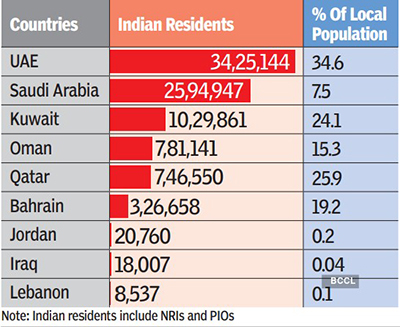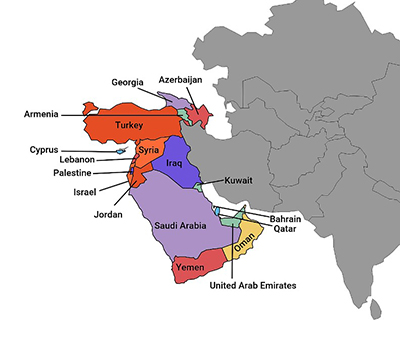Relevance: GS-2: Bilateral, regional and global groupings and agreements involving India and/or affecting India’s interests
Key Phrases: West Asia, Prophet Mohammad, Look West policy, Sovereign Wealth Funds, Crude oil, Energy security, Gulf Cooperation Council (GCC), Comprehensive Economic Partnership Agreement (CEPA).
Why in News?
- Recent comments from two spokespersons of the BJP related to Prophet Mohammad resulted in reactions from several west Asian countries with whom India has good relations.
- India’s relations with these countries have been shaped by energy needs, trade, and remittances from NRIs working there.
West Asia
- West Asia is the westernmost subregion of the larger geographical region of Asia, as defined by some academics, UN bodies, and other institutions.
- West Asia includes Armenia, Azerbaijan, Bahrain, Cyprus, Georgia, Iraq, Israel, Jordan, Kuwait, Lebanon, Oman, Palestine, Qatar, Saudi Arabia, Syria, Turkey, United Arab Emirates, and Yemen.
- It is almost entirely a part of the Middle East and includes Anatolia, the Arabian Peninsula, Iran, Mesopotamia, the Levant, the island of Cyprus, the Sinai Peninsula, and partly the Caucasus Region.
- The region is considered to be separated from Africa by the Isthmus of Suez in Egypt, and separated from Europe by the waterways of the Turkish Straits and the watershed of the Greater Caucasus.
- Eight seas surround the region (clockwise): the Aegean Sea, the Black Sea, the Caspian Sea, the Persian Gulf, the Arabian Sea, the Gulf of Aden, the Red Sea, and the Mediterranean Sea.
What Prompted the Government’s Response?
- Historical Ties:
- India’s cultural, economic, and trade relations with the countries of the West Asian region are deep and enduring.
- Starting with maritime trade, the exchange of goods, services, and cultures between the peoples of the Gulf region and the southern and western States of India, including the western shores of the Arabian Sea, reaches back many millennia and even from its foundation.
- The West Asian region also served as a land trade bridge for Greece, Rome, and other early European empires, and the rich trade in spices, cloth, silk, and indigo in exchange for gold and silver is well recorded.
- In a more contemporary historical context, the British colonial era saw the advent of a loose common monetary system with the rupee serving as legal tender in many Gulf States until the middle of the 20th century.
- It was also the discovery and subsequent commercial exploitation of oil in the Gulf region during the colonial era that began to alter the balance of trade flows between India and the countries of the region.
- Present Scenario:
- Today, countries in the West Asian region collectively account for
- one-sixth of India’s total bilateral trade and
- contribute about three-fifths of India’s crude oil supply.
- The region is a major provider of jobs and economic opportunities for Indian workers, professionals, and entrepreneurs and is home to approximately 8.9 million Indians.
- These Non-Resident Indians (NRIs) send home about $40 billion annually and contribute more than 55% of the country’s total remittance flows.
- Investments from Sovereign Wealth Funds and other large GCC investors have also grown rapidly in recent years, and India, which signed a Comprehensive Economic Partnership Agreement (CEPA) with the United Arab Emirates earlier this year, has become one of the biggest contributors to the region. Wants to significantly promote business relations by Negotiating more such trade and investment agreements.
- The government is avoiding any repercussions on this sensitive and potentially disruptive issue with large and rapidly growing economic interconnectedness.
- Today, countries in the West Asian region collectively account for
Why is India so Dependent on West Asian Countries for its Energy Needs?
- Crude oil:
- Domestic crude oil production, which has been declining over the years, meets less than a fifth of the country’s oil requirement, forcing India to rely on imports to fill the gap of over 80%.
- Trends in Diversification analyses that the share of Gulf countries of India’s total crude oil imports has remained fairly stable over the past 15 years at around 60%.
- In 2021-2022, the largest exporter of oil to India was Iraq, whose share has gone up from 9% in 2009-2010 to 22%.
- India’s top oil exporter was Iraq with a share of over 22%, followed by Saudi Arabia – at around 18%.
- UAE, Kuwait and Oman were other Gulf countries among the top-10 suppliers of crude oil to India in the financial year ended March 2021.
- A large proportion of India’s refineries are configured primarily to process sulfur-heavy sour grades of crude oil produced in the Gulf region and with comparatively sweet (low sulfur) grades of oil such as Brent.
- India’s crude oil purchases have gradually increased over the past two decades from Oman and Dubai.
- Natural Gas:
- Qatar accounts for 41% of India’s total natural gas imports.
- The UAE accounts for 11 natural gas exports to India%.

Do you know?
- The UAE was India’s third-largest trading partner in 2021-2022and second-largest for both exports (USD 28 billion) and imports (USD 45 billion) when these are counted individually.
- In terms of total trade volume, the UAE (USD 72.9 billion) was behind the United States (USD 1.19 trillion) and China (USD 1.15 trillion).
- The UAE accounted for 6.6% of India’s total exports and 7.3% of imports in the last financial year.
- Recently India and UAE signed a Comprehensive Economic Partnership Agreement (CEPA).
How Dependent is India on this Sector for Non-oil Trade?
- In the five years from 2017 to 2021, Iran and GCC member states including the United Arab Emirates, Saudi Arabia, Bahrain, Oman, Kuwait, and Qatar accounted for 15.3% of India’s cumulative two-way trade of $3.98 trillion over that period.
- According to the data available on the United Nations Comtrade
Database:
- Of the $609 billion in exports and imports from seven countries in this period, the United Arab Emirates contributed the lion’s share of $277.4 billion, or about 7%, making it one of India’s largest trading partners.
- Saudi Arabia was second with $153 billion.
- The region is today a major market for many Indian goods, from tea and basmati rice to electrical equipment, apparel, and machinery.
What is at Stake?
- In terms of remittances from abroad, India was the largest recipient in 2020 at USD 83.15 billion, according to World Bank data. West Asia is one of the most significant contributors to Indian remittances i.e. around $40 billion annually.
- The West Asian region provides the largest number of overseas jobs for Indians, with approximately 8.9 million Indians living and working in the Gulf economies.
- The United Arab Emirates, which includes the seven emirates of Dubai, Abu Dhabi, Sharjah Ajman, Umm al-Quwain, Fujairah, and Ras Al Khaimah, has the largest share of NRIs in the region and is home to more than 34 million Indians.
- Saudi Arabia with around 2.6 million and Kuwait with over 1 million are other major providers of jobs and economic opportunities for Indians.

- Indians are ubiquitous today with their presence in a vast array of job categories ranging from construction workers to oil industry workers, nurses and doctors in the medical sector to hospitality industry and finance professionals.
Conclusion:
- India’s interests in West Asia go beyond oil and gas.
- For India, West Asia is crucial in maintaining political stability in the Asian region and our primary source of oil imports.
- West Asia is critical in deciding foreign policies and even the domestic situation of India.
- With both economies integrating as GCC emerges as one of the biggest trading partners of India, it can enable tremendous cooperation in the future of geopolitics and neutralize Chinese aggression.
- India has always had a very strong and positive relations with the West Asian countries. One controversy started by some leaders on the fringe should not throw mud at the history of friendship, cooperation, and goodwill.
Source: The Hindu
Mains Question:
Q. Maintaining strong, positive relations with West Asian countries is important for India. Discuss.







